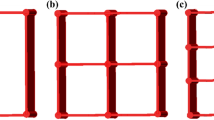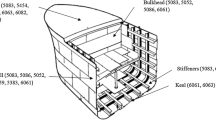Abstract
Faculty of Engineering at Shoubra has been funded to start a project for manufacturing railway sleepers from plastic wastes and iron slag to replace imported wooden sleepers. In this paper, performance of wooden sleepers in tracks of Egyptian Railways, including high cost and material defects as well as reasons to find out a new sleeper will be presented. Previous studies for using composite materials in manufacturing railway sleepers are illustrated. Mechanical testing has been carried out to determine the important properties of the new mixture; hence results are compared with the minimum requirements of the international railway standards. Linear analysis has been conducted using 3D-SAP2000 software to simulate the actual performance of the proposed sleeper. It is found that the testing results are larger than the required values. Thus; it is concluded that the tested material is effective and adequate to be used in manufacture of railway sleepers.






















Similar content being viewed by others
References
ENR (2002) Railway track guidelines. ENR, Cairo
Lichtberger B (2011) Track compendium. Eurail Press, Hamburg
Manalo A (2010) Fiber composite sandwich beam, Southern Region Engineering Conference 11–12 November. Toowoomba, Australia
Chandra S, Agarwal MM (2007) Railway engineering. Oxford University Press, Oxford
Japanese Railway Bureau (2012) Japanese Railway Standards, Chap. 3, Guide Way, JRB Japan
Harper CA (2006), Handbook of plastics technologies, McGraw Hill Companies, New York
U.S. Army Construction Engineering Research Laboratory (CERL) (1994) U.S. Plastic Lumber (USPL), Rutgers University Press, Rutgers
Anne R (2006) Rubber/plastic composite rail sleepers research project. Waste and resources action program, Banbury
Pattamaprom C et al (2005,).) Natural rubber composites for railway sleepers: a feasibility study. Thammasat University, Thailand
Miura S, Takai H, Uchida M, Fukuda Y (1998) The mechanism of railway tracks. Jpn Rail Transport Rev 3:38–45
Lampo R, Nosker T, Sullivan H (2003) Development, testing, and applications of recycled plastic composite cross ties. US Army Engineer Research and Development Center, Champaign
Hoger DI (2000) Fiber composite railway sleepers. University of Southern Queensland, Toowoomba
Van Erp G, Cattell C, Heldt T (2005) Fiber composite structures in Australia`s civil engineering market: an anatomy of innovation. Prog Struct Eng Mater 7:150–160.e
American Railway Engineering and Maintenance of-way Association (2013) Manual of Railway Engineering, AREMA, Lanham
American Society for Testing and Materials (2013) D6111-97, D696-98, D6108-97, D6109-97, D6117-97. ASTM, West Conshohocken, Pennsylvania
Bader S (2005) Crystic composites handbook. Scott Bader, Wollaston
TieTek (2016) Composite crossties technical data. Viewed: 09 Dec 2016, http://www.tietek.com/specsheets.php.
IntegriCo (2016) IntegriCo Composites. Viewed: 09 Dec 2016, http://www.integrico.com.
Axion-EcoTrax (2016) Axion EcoTrax composite railroad ties, viewed: 10 Dec 2016, http://www.axionintl.com
Woidasky J et al (2008) Railway sleepers from mixed plastic wastes – RailWaste, erscp 2008 organized by SUSPRISE. Berlin
Acknowledgements
The author would like to thank all staff of the Unit of Project Development in Ministry of Higher Education in Egypt, Benha University, Egyptian National railways and National Authority for Tunnels for their cooperation in providing the fund to purchase the required materials and to conduct the required testing. Also, the author thanks the engineers and technicians of the Egyptian Company for Manufacturing of Resin Products.
Author information
Authors and Affiliations
Corresponding author
Rights and permissions
About this article
Cite this article
Khalil, A.A. Mechanical Testing of Innovated Composite Polymer Material for using in Manufacture of Railway Sleepers. J Polym Environ 26, 263–274 (2018). https://doi.org/10.1007/s10924-017-0940-6
Published:
Issue Date:
DOI: https://doi.org/10.1007/s10924-017-0940-6




